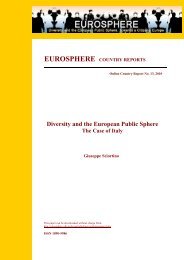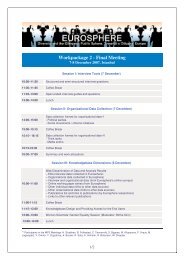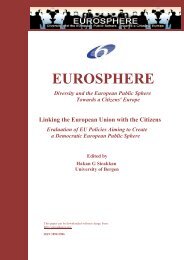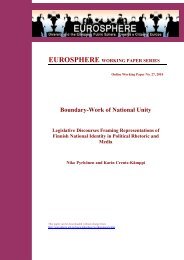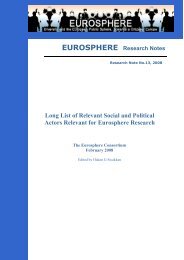Migrants, Minorities, Belongings and Citizenship. Glocalization and ...
Migrants, Minorities, Belongings and Citizenship. Glocalization and ...
Migrants, Minorities, Belongings and Citizenship. Glocalization and ...
Create successful ePaper yourself
Turn your PDF publications into a flip-book with our unique Google optimized e-Paper software.
2.2.4. Multidimensional belongings in glocal spaces<br />
Respondents’ belonging patterns have been mapped along the eleven dimensions, which<br />
are shown in the first column of Table 6. Classification of the respondents (or value<br />
assignment to the cases) has been done in two stages. In the first stage, the<br />
respondents were classified with respect to their responses to the questionnairequestions<br />
asking them about their belongings. In the second stage, the in-depth<br />
interview transcriptions, the evaluations prepared by the field-researchers <strong>and</strong> the<br />
information given in the respective country reports were used to refine the first-stage<br />
classification. In connection with this refinement in the second stage, some valuable<br />
information came up which enabled us to do a more correct classification. Moreover,<br />
some questionnaire items which were left unanswered by the respondents were indeed<br />
answered during the in-depth interviews. Thus, the data from the in-depth interviews<br />
enabled us to create a data set with minimum missing data.<br />
It is important to note that the results presented in the following sections are based on<br />
raw-data which the research partners delivered to the coordinator. It is also important to<br />
stress that the data presented in this section as well as those in the following sections<br />
are not from a statistically representative sample. The tables <strong>and</strong> figures are quantified<br />
presentation of the qualitative data collected. 5 Therefore, they should not be interpreted<br />
as a portrayal of different groups’ or countries’ representative profiles. They basically<br />
represent the state of affairs in what we call “glocal spaces” in six European cities. The<br />
aim at this very stage is merely to illustrate systematically the structure <strong>and</strong> features of<br />
the data collected <strong>and</strong> to construct the variables to be used in further causality analyses<br />
in the subsequent sections.<br />
One aspect that should be emphasized is that most respondents have multidimensional<br />
belongings. Table 6 illustrates the results from a categorical principal components<br />
analysis (CATPCA) with ordinal variables. The results show five main types of<br />
multidimensional belonging patterns in the project’s data set.<br />
Before interpreting the results, for those readers who are not familiar with principal<br />
components analysis with categorical variables (CATPCA), some introductory notes may<br />
be useful. Like the conventional principal components analysis with continuous variables<br />
(PCA), the CATPCA-procedure also uncovers the “hidden” dimensions in the relationship<br />
between a single set of categorical variables in a given data set. In other words, it is a<br />
5 As we shall see in the subsequent subsections, this was done by using quantification methods such as optimal<br />
scaling (e.g. categorical principal components <strong>and</strong> categorical regression analyses).<br />
67



